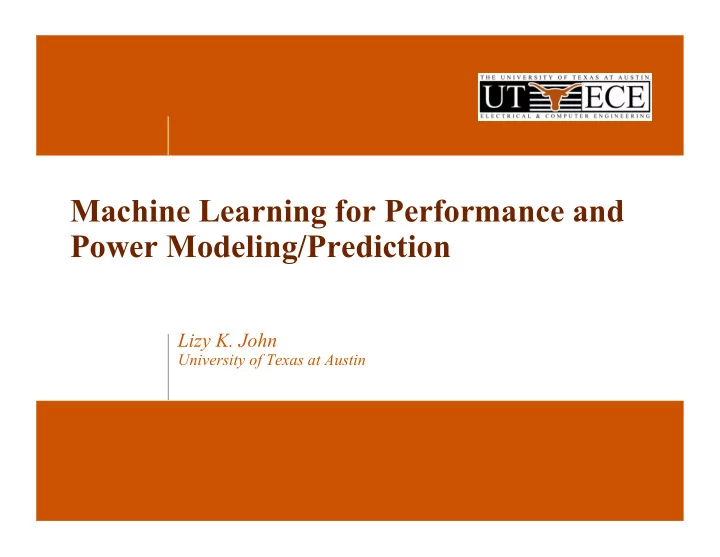

PACT 2010 Machine Learning for Performance and Power Modeling/Prediction Lizy K. John University of Texas at Austin
Simulation Challenges § Simulation Based Performance Models § eg: SimOS, SIMICS, GEM5, SimpleScalar § Power modeling § eg: McPAT, CACTI § Full system Simulation is prohibitively slow § Simulation errors § Large Gap between what’s evaluated pre-silicon and what’s run post-silicon 2
Three Examples for Using Machine Learning in Performance/Power Modeling and Prediction § Calibration of Power Models using Machine Learning § Cross-Platform Performance/Power Prediction using Machine Learning § Stressmarks and Power Viruses using Machine Learning 3
Example 1 Machine Learning for Model Calibration ISLPED 2015 Lizy K. John 5/12/17
Example 1 Machine Learning for Model Calibration Lizy K. John 5/12/17
Example 1 Correction Factors – Additive and Multiplicative Non-negative Least Square Error Solver Lizy K. John 5/12/17
Example 1 Training Process Lizy K. John 5/12/17
Example 1 Training Process Lizy K. John 5/12/17
Example 1 Machine Learning for Model Calibration Lizy K. John 5/12/17
Example 1 Calibrated Power Lizy K. John 5/12/17
Example 2 Machine Learning for Cross-Platform Prediction Motivation: Full System Simulation is too slow. Analytical Models are not accurate enough. Bridge the gap between the two using machine learning. Intuition: Performance on two platforms is correlated. Can machine learning be used to understand that correlation? Lizy K. John 5/12/17
Example 2 Machine Learning for Cross-Platform Prediction (DAC 2016, DATE 2017) Constrained LASSO Regression Lizy K. John 5/12/17
Example 2 Use Cases for Cross-Platform Prediction Slow Simulator – No time to run all benchmarks but fast previous generation or other ISA hardware available - Run some benchmarks and use machine learning Limited Access to New Hardware – Make some runs – Train using them and predict power of other benchmarks Hardware Software Co-development - If they can run code on existing hardware and predict based on the cross-platform model provided by hardware developer Lizy K. John 5/12/17
Learning Formulation Lizy K. John 5/12/17
Example 2 Training Set – ACM Programming Contest Lizy K. John 5/12/17
Example 2 Profiling for Training Lizy K. John 5/12/17
Example 2 Performance Prediction Accuracy Lizy K. John 5/12/17
Example 2 Power Prediction - Accuracy Lizy K. John 5/12/17
Example 2 Prediction at Fine-grain Lizy K. John 5/12/17
Example 2 Power Prediction at Fine-grain Lizy K. John 5/12/17
Example 2 Average Cross-Validation Error: 10-fold cross-validation Lizy K. John 5/12/17
Example 2 Non-Linearity of F Lizy K. John 5/12/17
Example 2 Lizy K. John 5/12/17
Example 2 Lizy K. John 5/12/17
Example 2 Challenges in Cross-Platform Prediction Host Sensitivity Instrumenting Source Method Aligning in No-Source (Perf Counter based) Methodology Stochastic Dynamic Coupling Requires Solving Regression during Prediction More work to be done but cross-platform prediction seems feasible. Lizy K. John 5/12/17
Example 3 Challenges in Creating Max-power Viruses § Hand crafting code snippets for power viruses – Very tedious process, complex interactions inside the processor – Cannot be sure if it is the maximum case – Heavily architecture dependent; heavy domain knowledge § Automatically generate power viruses 26 Laboratory for Computer Architecture
Example 3 Power measurement of Viruses on Hardware § BurnK7 – 72.1 Watts § SPEC CPU2006: 416.gamess and 453.povray consume highest power of 63.1 and 59.6 Watts 27 Laboratory for Computer Architecture
Example 3 Power Proxies and Viruses using Machine Learning Machine Power Virus Learning Power estimates Fitness values 1,2 … n Abstract workload Power/Perf specs Simulator Code Synth … Synth Synth 1 n 2 Generator 28 Laboratory for Computer Architecture 11/16/2011
Example 3 Proxy Workload Generation – Derive proxy applications from a set of workload characterizations – Proxies convey no proprietary information, but capture the execution behavior of developer’s applications – Proxy applications have similar power and performance characteristics as original Original Workloads Proxies are miniature and can be run on RTL Power can be modeled on RTL without OS and without software stack Performance/Power Clones
Example 3 Automatic Synthetic Benchmark Generation 30 Laboratory for Computer Architecture
Example 3 Power Virus Generation using Machine Learning Machine Power Virus Learning Power estimates Fitness values 1,2 … n Abstract workload Power/Perf specs Simulator Code Synth … Synth Synth 1 n 2 Generator 31 Laboratory for Computer Architecture
Example 3 SYMPO and MAMPO Frameworks § Automatically search for power viruses using an abstract workload model and machine learning § GA: search heuristic to solve optimization problems § Choose a random population, evaluate fitness, apply GA operators to generate next population § Evolve until required fitness achieved 32 Laboratory for Computer Architecture
Example 3 SYMPO Framework – Genetic Algorithm Single-point Crossover Single-point Mutation – Individuals -> synthetic workloads, – Fitness function -> power on the design under study – Mutation rate, reproduction rate, crossover rate 33 Laboratory for Computer Architecture
Example 3 SYMPO Vs Mprime on SPARC ISA Config 1 - 14% more Config 2 - 24% more Config 3 - 41% more 34 Laboratory for Computer Architecture
Example 3 Comparison to SPEC CPU2006 on SPARC ISA § Comparison to SPEC CPU2006: 74.4Watts compared to 89.8Watts in SYMPO 35 Laboratory for Computer Architecture
Example 3 Comparison to SPEC CPU2006 on Alpha ISA § Comparison to SPEC CPU2006: 111.8 Watts compared to 89.2 Watts, where theoretical maximum is 220 Watts 36 Laboratory for Computer Architecture
Example 3 Validation on x86 Hardware 78 73 68 Power (W) 63 58 53 48 Benchmarks § The auto-generated stressmark (SYMPO) could beat the hand-tuned burnk7 37 Laboratory for Computer Architecture
Summary Machine Learning Techniques can be used to improve Power Modeling and Prediction. Cross-Platform Prediction using Machine Learning can accurately track performance and power at phase level. Synthetic Stressmarks created using Genetic Algorithms can excel hand-generated stressmarks. Lizy K. John 5/12/17
BPOE 2014 Thank You! Questions? Laboratory for Computer Architecture (LCA) The University of Texas at Austin lca.ece.utexas.edu Lizy K. John 5/12/17
Recommend
More recommend